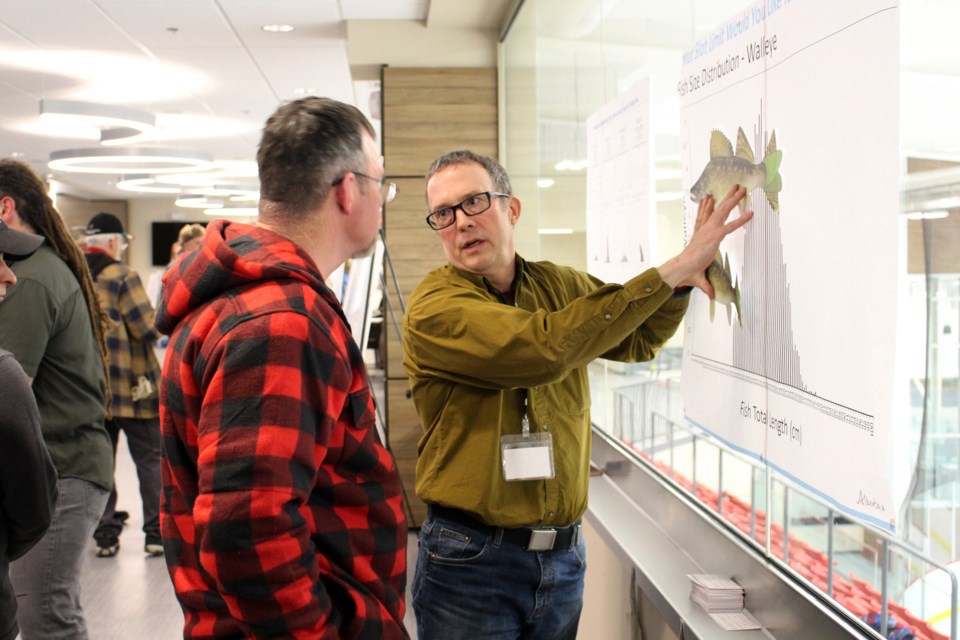COLD LAKE – Alberta Environment and Parks threw their line out hoping to get a nibble from local anglers.
During the fisheries management open house at the Cold Lake Energy Centre on Monday, Jan. 20, the province was looking for feedback on topics such as slot limits for walleye and northern pike, and less restrictive harvest opportunities.
“It was an opportunity for us to speak with anglers and the public to get some ideas from them about their thoughts on some of the fisheries that we have here,” explained Jordan Walker, resource manager in the lower Athabasca region for Alberta Environment and Parks. “We know that, for us and for them, engagement is really important and we want to make sure that we have an opportunity to talk about fisheries management with them.”
The information gathered will be considered ahead of the 2020 sportfishing regulations coming into affect April 1.
One suggestion the province is considering is stocking walleye, which is raising fish in a hatchery before releasing them into a river or lake to supplement the existing population. Although the process would begin this year, the walleye population likely wouldn’t reach the desired numbers for harvest for four or five years. Local water bodies including Crane Lake, Tucker Lake, Helena Lake, Ernestina Lake, and Angling Lake were listed as the spots it could be implemented in 2020.
Walleye regulations in 2019 for certain lakes, such as for Moose Lake, required anglers to apply for tags in order to bring the fish they catch home to allow the populations to increase.
Cold Lake resident John Nelson wanted to know what the province has in store for Marie Lake in particular.
He said, “They closed it to both northern pike and pickerel and I know for a fact there’s a multitude of fish in that lake. I can go out any day of the week and catch 25 or 30 fish in an hour and I don’t use bait,” he detailed.
Ron Mikolas also had some concerns when it came to fishing in the water body.
“It’s a lake that’s quite large, and it seems to have a pretty good population of walleye,” noted the Cold Lake resident. “Presently, you’re not allowed to keep walleye from Marie Lake. I’ve been fishing there this winter for burbot, and I’ve been catching walleye through the ice, but very few burbot.”
Anglers who headed out on Marie Lake were allowed to catch up to 10 lake whitefish and 15 yellow pike according to the 2019 regulations, but walleye and northern pike were off-limits.
Moving fish from one body of water to another to create new fishing opportunities or to add to existing ones was one proposal from the province to deal with overpopulation, including in Minnie Lake and Chicken Hill Lake. Species that could be relocated are yellow perch, northern pike, and golden trout.
One suggestion raised by attendee Tim Kalinski to address the number of species anglers have been seeing was by removing restrictions altogether.
“The ecosystem and habitat in a lake can only sustain so many fish, and the lakes are no longer netted so we’re not taking out the huge population of whitefish, suckers, and burbot. They just keep populating, there’s no control of those, so I think the lakes are just overrun in a lot of cases. I don’t know what the answer is, but I think we need to do something different.”
Little Bear Lake and Chatwin Lake were included as possible locations for diversified trout stocking, which would see new trout fisheries created for anglers in areas that are already stocked. Species added in could comprise of brook, brown, tiger, and cutthroat trout.
The main focus of the open house was to gather feedback from those who fish on the local lakes, Walker stated.
“We’ve heard from anglers that they’re interested in additional harvest opportunities, trying some options, and we’ve heard they want more engagements with us face-to-face,” he noted. “This was one of those chances where we could hear from them and say ‘what kinds if opportunities would you be interested in?’ and see how we can manage to incorporate some of that.”
Among those in attendance was MD of Bonnyville Coun. Ben Fadeyiw, who thought providing comments to the province was crucial to encouraging tourism in the area.
“As a kid growing up, I always fished in the lakes and it was easily accessible to fish. Now, it’s not and the MD has put a lot of money into boat docks and things like that so we want our residents to use it and, not only residents, but people from other peoples to bring tourism dollars. I think there’s some challenges, and I think it’s important for everybody to come out and voice their opinions,” he said.
Nelson described the drop-in format as better than previous events hosted by the province.
“In the past, they said it was a meeting to discuss proposals for the lakes and you walk into the meeting to have the biologists stand up and say ‘this is the way its going to be, and there’s not a darn thing you can do about it,’” Nelson recalled.
Kalinski agreed, “We’ve done them before where other governments haven’t listened. Hopefully, our new government is going to listen.”
Throughout the rest of January, similar open houses in locations like St. Albert and Calgary will be hosted to collect more feedback from anglers. For those unable to attend an event, there’s also a survey available online at TalkAEP.Alberta.ca.



